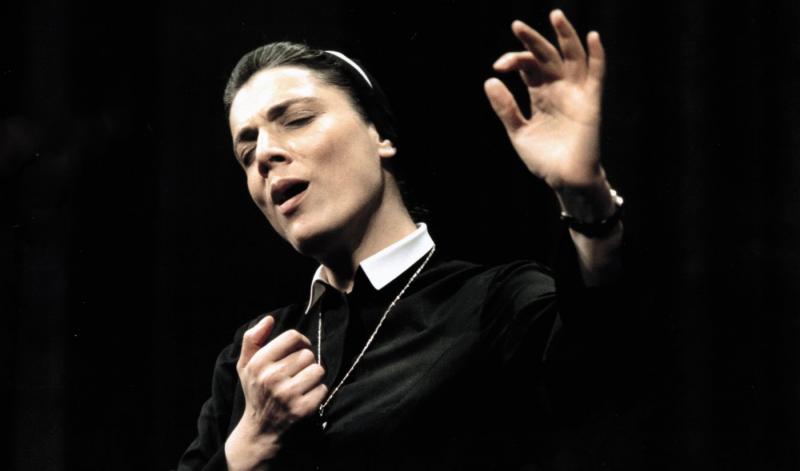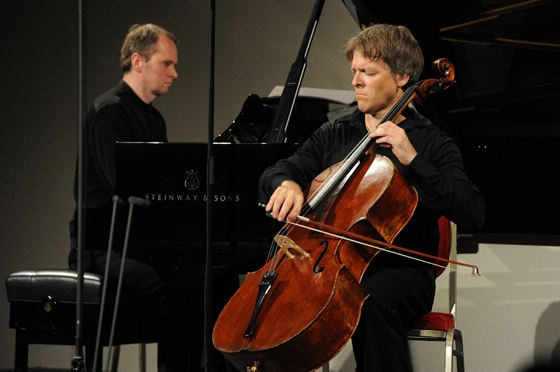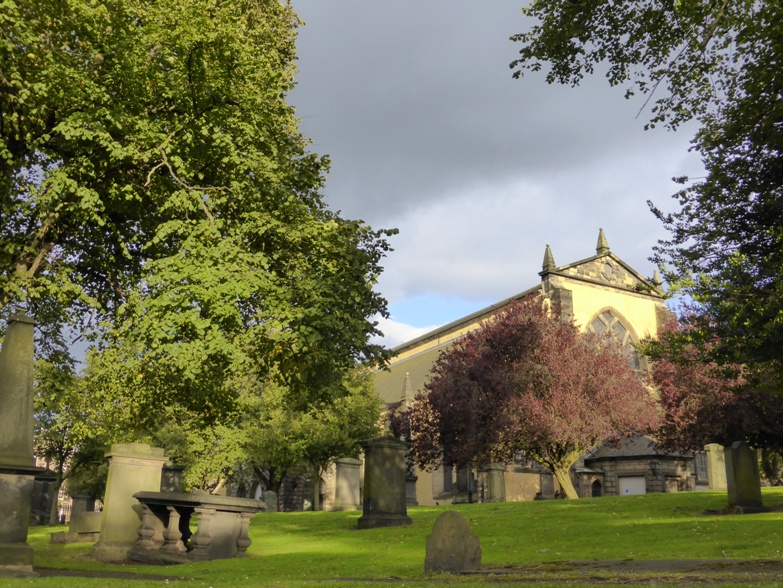Gerhardt, Osborne, Queen's Hall/Keyrouz, Ensemble de la Paix, Greyfriars Kirk, Edinburgh | reviews, news & interviews
Gerhardt, Osborne, Queen's Hall/Keyrouz, Ensemble de la Paix, Greyfriars Kirk, Edinburgh
Gerhardt, Osborne, Queen's Hall/Keyrouz, Ensemble de la Paix, Greyfriars Kirk, Edinburgh
Perfect cello and piano duo spotlights Britten, with eastern liturgical music to follow

“Ah now, I can’t promise you sun,” says a Scots lady-in-waiting of her native weather to a novice Englishwoman near the start of Rona Munro’s masterly James Plays. It’s the first of many references to make the audience laugh knowingly. Well, after four days of the worst weather Edinburgh Festivalgoers can remember, the sun came out yesterday morning.
Chamber music needs as much programming reform as orchestral concerts: just as overture, concerto, symphony is a format that’s slowly metamorphosing into something richer and more daring, the usual string of sonatas for solo instrument and piano looks like being superseded. Not that three or four duo works in a row would ever be grey in the hands of cellist Alban Gerhardt and his frequent recital partner, that challenging pianist Steven Osborne (pictured below). But by choosing to begin apart, they varied the strain of a rich and logical sequence (*****).
 Starting with Britten’s First Suite for solo cello, Gerhardt fused the rock of the refrains and the dark waters that eddy around it into one textured continuum. The composer may have subtitled his sequence “Divertissement”, but Gerhardt bound it all together with an introspective restlessness that came hauntingly to hover in a nursery tune over a persistent D before a giddying Moto perpetuo ran headlong into the return of the opening strain, questioning to the last.
Starting with Britten’s First Suite for solo cello, Gerhardt fused the rock of the refrains and the dark waters that eddy around it into one textured continuum. The composer may have subtitled his sequence “Divertissement”, but Gerhardt bound it all together with an introspective restlessness that came hauntingly to hover in a nursery tune over a persistent D before a giddying Moto perpetuo ran headlong into the return of the opening strain, questioning to the last.
The artistic finish of Gerhardt’s held notes fading into nothing found its match in Osborne’s conquest of Tippett’s Fourth Piano Sonata. He had given us the Second and Third earlier this year in another concert of two satisfying halves, with the Heath Quartet taking up an unexpected late masterpiece after the interval. That the final quartet was an isolated breakthrough in the doodlings of Tippett’s last years seemed rather confirmed by the meandering of the last sonata. Its first and third movements flip between the starburst twitterings of the ecstatic early, Midsummer Marriage style and stony chords or unisons (some of us, sitting at the piano improvising, have come up with something similar of lesser density).
This is one case where if you didn’t know the piece – and I wasn’t familiar with it - reading the programme first would have prepared for the shock of a properly lively seeming finale giving way to an interminable slow movement. If this was heaven for Tippett, it sounded like a rocky and comfortless place. So, glad as I am to have heard it once in concert, the preceding and relatively compressed sonatas are surely more worth revisiting.
There’s nothing arid or protracted about Beethoven’s late C major Sonata for Cello and Piano. Its meadows of luminous calm contrast with purposeful activity punctuated by more surprises (the finale’s leaps and pauses, stunningly fresh here). Gerhardt and Osborne played off each other with what, this time, felt like the right sort of improvisatory quality, and they signed off officially with another work that’s also in C but rarely feels like it: back to Britten, and the total masterpiece of his offering to Rostropovich. Nothing makes more singular play of piano and cello questions and answers (or perhaps just more questions) than the furtive opening of the Cello Sonata; there is no darker elegy in the composer’s harrowed catalogue than this slow movement other, perhaps, than the one in the Cello Symphony.
It speaks volumes of this duo that you think much more about the genius of the work itself than what good players they are. A mobile went off in consonant approval of the fourth-movement Marcia; they had so dug us into the mood that it hardly mattered. This was the perfect partnership, rounded off with devastating, minimally gilded simplicity in the second of Schumann’s "Fünf Stücke im Volkston. Writing for theartsdesk of Monday afternoon's Greyfriars opener, Christopher Lambton said of the Messiaen Quartet for the End of Time in which they played that the concert was "as near perfect as any I have heard". I feel the same about this recital, if not all of its music; festivalgoers may hear another Queen’s Hall concert as good, but not better.
 Relatively mixed feelings here about the one-off of Sister Marie Keyrouz’s manifestation (***) in Greyfriars Kirk . A Maronite Christian from Lebanon, she founded her Ensemble de la Paix during the 1984 bombing of Lebanon “to promote the spiritual and the beautiful”, extended its membership to musicians from all countries of the Middle and Far East, and all religions, and uses the profits from concerts and CDS to educate disadvantaged children through the world. She has an assured energy and a focus that are palpably sincere; the mystical pianissimos and the radiant, dance-like trumpet sounds at the other end of the dynamic scale are absolutely in the spirit of the Arab-inflected music she and her male singers present from the Aramaic, Maronite and Byzantine traditions.
Relatively mixed feelings here about the one-off of Sister Marie Keyrouz’s manifestation (***) in Greyfriars Kirk . A Maronite Christian from Lebanon, she founded her Ensemble de la Paix during the 1984 bombing of Lebanon “to promote the spiritual and the beautiful”, extended its membership to musicians from all countries of the Middle and Far East, and all religions, and uses the profits from concerts and CDS to educate disadvantaged children through the world. She has an assured energy and a focus that are palpably sincere; the mystical pianissimos and the radiant, dance-like trumpet sounds at the other end of the dynamic scale are absolutely in the spirit of the Arab-inflected music she and her male singers present from the Aramaic, Maronite and Byzantine traditions.
Yet it may be advanced years that find Sister Marie pitching microtonally but surely not intentionally above her colleagues. And though a programme was to hand with texts, we were liable to be quickly lost as to which piece belonged to which tradition, at least until the Byzantine trio of settings at the end and the radiant “Christos anesti” encore. So in the cause of education and understanding I’d welcome some verbal presentation. And some elders of the packed Greyfriars audience behaved abysmally during the music: snapping with their iPhones before promptly falling asleep, walking around on creaking wooden floorboards, texting with intermittent beeps (the tweedy lady behind me). The best this sequence had to offer was a quiet meditation; due to the inattentive listeners around me it was anything but that.
Share this article
The future of Arts Journalism
You can stop theartsdesk.com closing!
We urgently need financing to survive. Our fundraising drive has thus far raised £49,000 but we need to reach £100,000 or we will be forced to close. Please contribute here: https://gofund.me/c3f6033d
And if you can forward this information to anyone who might assist, we’d be grateful.

Subscribe to theartsdesk.com
Thank you for continuing to read our work on theartsdesk.com. For unlimited access to every article in its entirety, including our archive of more than 15,000 pieces, we're asking for £5 per month or £40 per year. We feel it's a very good deal, and hope you do too.
To take a subscription now simply click here.
And if you're looking for that extra gift for a friend or family member, why not treat them to a theartsdesk.com gift subscription?
more Classical music
 First Person: clarinettist Oliver Pashley on the new horizons of The Hermes Experiment's latest album
Compositions by members of this unusual quartet feature for the first time
First Person: clarinettist Oliver Pashley on the new horizons of The Hermes Experiment's latest album
Compositions by members of this unusual quartet feature for the first time
 Gesualdo Passione, Les Arts Florissants, Amala Dior Company, Barbican review - inspired collaboration excavates the music's humanity
At times it was like watching an anarchic religious procession
Gesualdo Passione, Les Arts Florissants, Amala Dior Company, Barbican review - inspired collaboration excavates the music's humanity
At times it was like watching an anarchic religious procession
 Classical CDs: Camels, concrete and cabaret
An influential American composer's 90th birthday box, plus British piano concertos and a father-and-son duo
Classical CDs: Camels, concrete and cabaret
An influential American composer's 90th birthday box, plus British piano concertos and a father-and-son duo
 Cockerham, Manchester Camerata, Sheen, Martin Harris Centre, Manchester review - re-enacting the dawn of modernism
Two UK premieres added to three miniatures from a seminal event of January 1914
Cockerham, Manchester Camerata, Sheen, Martin Harris Centre, Manchester review - re-enacting the dawn of modernism
Two UK premieres added to three miniatures from a seminal event of January 1914
 Kempf, Brno Philharmonic, Davies, Bridgewater Hall, Manchester review - European tradition meets American jazz
Bouncing Czechs enjoy their Gershwin and Brubeck alongside Janáček and Dvořák
Kempf, Brno Philharmonic, Davies, Bridgewater Hall, Manchester review - European tradition meets American jazz
Bouncing Czechs enjoy their Gershwin and Brubeck alongside Janáček and Dvořák
 Solomon, OAE, Butt, QEH review - daft Biblical whitewashing with great choruses
Even a top soprano and mezzo can’t make this Handel paean wholly convincing
Solomon, OAE, Butt, QEH review - daft Biblical whitewashing with great choruses
Even a top soprano and mezzo can’t make this Handel paean wholly convincing
 Two-Piano Gala, Kings Place review - shining constellations
London Piano Festival curators and illustrious friends entertain and enlighten
Two-Piano Gala, Kings Place review - shining constellations
London Piano Festival curators and illustrious friends entertain and enlighten
 Echo Vocal Ensemble, Latto, Union Chapel review - eclectic choral programme garlanded with dance
Beautiful singing at the heart of an imaginative and stylistically varied concert
Echo Vocal Ensemble, Latto, Union Chapel review - eclectic choral programme garlanded with dance
Beautiful singing at the heart of an imaginative and stylistically varied concert
 Scott, Irish Baroque Orchestra, Whelan, RIAM, Dublin review - towards a Mozart masterpiece
Characteristic joy and enlightenment from this team, but a valveless horn brings problems
Scott, Irish Baroque Orchestra, Whelan, RIAM, Dublin review - towards a Mozart masterpiece
Characteristic joy and enlightenment from this team, but a valveless horn brings problems
 Classical CDs: Voice flutes, flugelhorns and froth
Baroque sonatas, English orchestral music and an emotionally-charged vocal recital
Classical CDs: Voice flutes, flugelhorns and froth
Baroque sonatas, English orchestral music and an emotionally-charged vocal recital
 Kanneh-Mason, Britten Sinfonia, Shave, Milton Court - a grin and a big beaming smile
A pair of striking contemporary pieces alongside two old favourites
Kanneh-Mason, Britten Sinfonia, Shave, Milton Court - a grin and a big beaming smile
A pair of striking contemporary pieces alongside two old favourites

Add comment